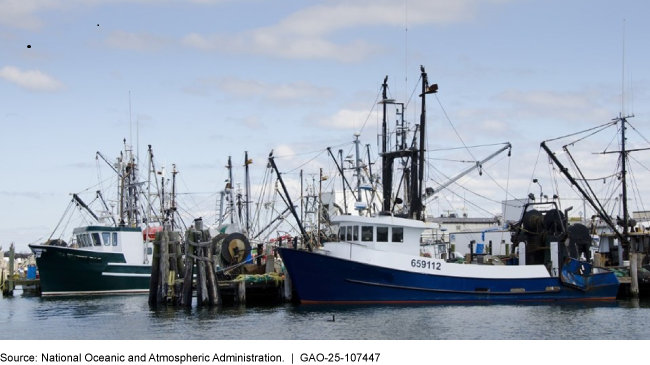Army Corps of Engineers: Commercial Fishing Data Could Help Inform Budget Process
Fast Facts
The Army Corps of Engineers maintains harbors and channels that people use to transport commercial goods and fish caught offshore.
The Corps collects data about the tons of goods and the pounds of fish traveling through these ports. It prioritizes funding for maintenance and construction projects based on the tons of goods that pass through. However, the Corps does not include the commercial fishing data in those calculations.
We recommended assessing whether the Corps should include its commercial fishing data in its budget decision-making process.

Highlights
What GAO Found
The U.S. Army Corps of Engineers’ Waterborne Commerce Statistics Center (Center) collects data on waterborne commerce, or the transport of commercial goods over waterways. The Corps uses waterborne commerce data to inform how it prioritizes funding for navigation projects. This helps ensure that federal harbors and channels remain navigable for vessels bringing goods to U.S. ports. For cargo transported between ports—which includes a wide variety of goods and reflects the many sectors of the nation’s economy—the Center collects data on tons of cargo, or tonnage, from vessel operators, other agencies, and a third-party vendor.
For fish caught offshore and brought to port for sale, known as commercial fish landings, the Center collects data on pounds of fish landed from a database maintained by the National Oceanic and Atmospheric Administration’s National Marine Fisheries Service (NMFS).
Ports of Houston, Texas and Dutch Harbor, Alaska

Why GAO Did This Study
The Water Resources Development Act of 2022 includes a provision for GAO to conduct a review of the Center’s collection and reporting of waterborne commerce data, including data on commercial fishery landings and aquaculture harvest. This report provides information on the Center’s collection and use of these data.
To inform this work, GAO reviewed and analyzed laws, regulations, policies, and guidance relevant to the Center’s collection of waterborne commerce data, and documents related to the Corps’ use of waterborne commerce data in its budget decision-making. GAO also met with Corps officials to understand the agency’s collection and use of waterborne commerce data, and reviewed data in the Corps’ Waterborne Commerce of the United States Calendar Year 2022. To better understand the commercial fish landings data collected by the Center, GAO met with officials from NMFS, and reviewed data available for fiscal year 2022 through the agency’s Fisheries One Stop Shop database.
Recommendations
GAO is recommending to the Corps that it conduct and document an assessment to determine whether incorporating commercial fish landings data into tonnage could impact the agency’s prioritization of navigation projects. If the agency determines that the inclusion of these data could impact the Corps’ prioritization of navigation projects, it should document a plan to include commercial fish landings data in tonnage.
Recommendations for Executive Action
| Agency Affected | Recommendation | Status |
|---|---|---|
| Civil Works | The Assistant Secretary of the Army for Civil Works should ensure that the Chief of Engineers and Commanding General of the U.S. Army Corps of Engineers conduct and document an assessment to determine whether incorporating commercial fish landings data into tonnage could impact the Corps' prioritization of navigation projects. If the agency determines that the inclusion of these data could impact the Corps' prioritization of navigation projects, it should document a plan to include commercial fish landings data in tonnage. |
When we confirm what actions the agency has taken in response to this recommendation, we will provide updated information.
|
